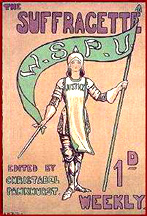This document came from Helena Wojtczak's English Social History: Women of Nineteenth-Century Hastings and St.Leonards. An Illustrated Historical Miscellany, which the author had graciously shared with readers of the Victorian Web about fifteen years ago. Outbound links had become boroken, and have been eliminated, but it is still possible to find Helena and her valuable and extensive historical material. Click on: Hastings Women's History for her table of contents. — JB
In 1866, Hastings resident Barbara Leigh Smith Bodichon had drafted and promoted a petition for votes for women, thus sowing the seeds of a nationwide movement for votes for women. Over the next forty years, suffrage groups sprung up all over the country. The first in Hastings & St Leonards was the London National Society, which was began in the 1870s-80s and later came under the umbrella of the NUWSS. There was also a Hastings Association for the Promotion of Women's Rights which, in 1876, presented MP Thomas Brassey with a suffrage petition, which he took to Parliament. In 1890 Brassey married Sybil De Vere Capell and, as Earl and Countess Brassey, they later became NUWSS activists.


The Appeal of Womanhood and The WSPU newspaper -- The Suffragette
Around 1908 a branch of the militant suffragettes, the WSPU, was established. There were also branches of the Tax Resistance League, the Free Church League for Women's Suffrage (Chairman: Jane E Strickland), the Catholic Women's Suffrage League (Secretary: Miss I Willis), the Men's League for Women's Suffrage, the Women's Suffrage Propaganda League (secretary: Mrs Darent Harrison) and the Women's Freedom League.
The societies in Hastings were very active: each held weekly meetings plus ad hoc talks and lectures. Plays, films and church services were attended and sometimes interrupted. Open air meetings were held in Wellington Square and on the beach in front of the De Luxe Cinema, Pelham Place. Public rallies with famous national speakers drew huge crowds to the Public and Metropole halls. There were poster-parades, processions, and self-denial weeks to raise funds. Women chalked the pavements to advertise forthcoming events and sold copies of The Suffragette and Votes for Women in the streets. Some very prominent local people and clergy lent their support.
In February 1918 female householders aged over 30 were granted the vote, 62 years after Barbara Leigh Smith Bodichon's petition. This of course takes us well past the Victorian period.
Created 14 May 2007
Last modiifed 19 October 2022 (broken links removed)